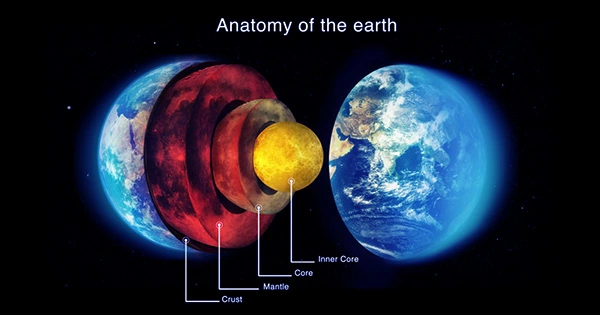The Earth’s solid inner core’s iron atoms are densely packed together by astronomically high pressures—the highest on the planet.
Researchers have discovered that there is still potential for wriggle room.
A study led by The University of Texas at Austin and collaborators in China discovered that certain groups of iron atoms in the Earth’s inner core can move rapidly, changing places in a fraction of a second while maintaining the underlying metallic structure of the iron—a type of movement known as “collective motion” that is analogous to dinner guests changing seats at a table.
The findings, based on laboratory studies and theoretical models, suggest that atoms in the inner core move significantly more than previously anticipated.
The findings could help explain a number of mysterious inner core features that have long puzzled scientists, as well as offer insight into the function the inner core plays in powering Earth’s geodynamo—the enigmatic process that generates the planet’s magnetic field.

“We now understand the fundamental mechanism that will help us understand the dynamic processes and evolution of the Earth’s inner core,” said Jung-Fu Lin, a professor at the University of Tennessee Jackson School of Geosciences and one of the study’s primary authors.
Because of the extraordinarily high temperatures and pressures, scientists are unable to directly sample the Earth’s inner core. Lin and colleagues recreated it in the lab in miniature by firing a small iron plate with a fast-moving bullet. The experiment’s temperature, pressure, and velocity measurements were then fed into a machine-learning computer model of atoms in the inner core.
Iron atoms in the inner core, according to scientists, are grouped in a repeating hexagonal arrangement. Most computer simulations depicting the lattice dynamics of iron in the inner core, according to Lin, show just a tiny number of atoms—usually fewer than a hundred. Using an AI system, the researchers were able to greatly improve the atomic environment, resulting in a “supercell” of approximately 30,000 atoms that could more correctly forecast iron’s properties.
The scientists witnessed groups of atoms moving around and changing locations at this supercell scale while maintaining the overall hexagonal arrangement.
According to co-lead author Youjun Zhang, a professor at Sichuan University, the atomic movement could explain why seismic readings of the inner core show an environment that is considerably softer and pliable than would be expected under such pressures.
“Seismologists have found that the center of the Earth, called the inner core, is surprisingly soft, kind of like how butter is soft in your kitchen,” he stated. “We discovered that solid iron becomes surprisingly soft deep inside the Earth because its atoms can move much more than we ever imagined.” This increased mobility makes the inner core less stiff, making it more vulnerable to shear forces.”
The researchers stated that their research was driven by the need to provide an explanation for the “surprisingly soft” physical features exhibited in the seismic data.
According to the researchers, the inner core accounts for roughly half of the geodynamo energy that generates the Earth’s magnetic field, with the outer core accounting for the remainder. The new atomic-scale understanding of inner core activity can help inform future research on how energy and heat are generated in the inner core, how it relates to the dynamics of the outer core, and how they work together to generate the planet’s magnetic field, which is a key ingredient for a habitable planet.
















